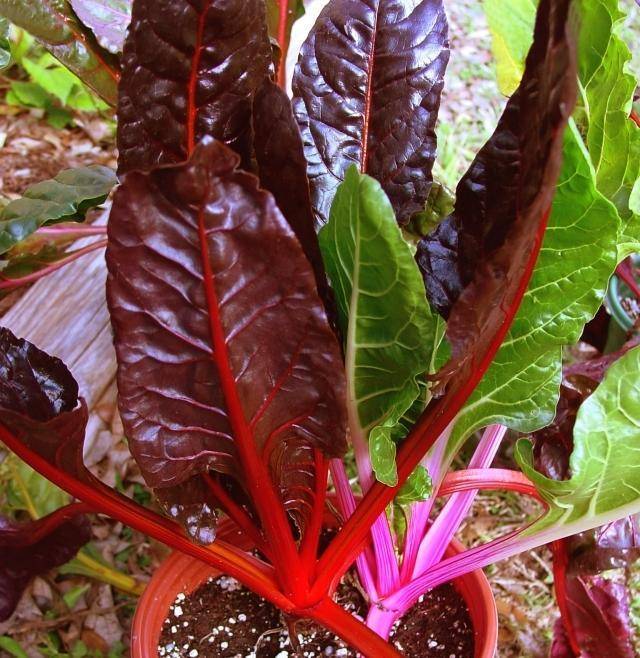 One of the first greens in the spring and one of the last in the fall, Swiss chard is amazingly hardy. It will grow in almost any soil and will thrive even with neglect. Swiss chard is definitely best when locally raised as its texture changes dramatically during shipping and not for the better. When young, Swiss chard leaves are so tender they can be used for salads. As the leaves mature, they can substitute for spinach in pasta dishes and sturdier varieties of kale in soups and legume stews. You also can chop the stems and use them in vegetable sautés and stir-fries.
One of the first greens in the spring and one of the last in the fall, Swiss chard is amazingly hardy. It will grow in almost any soil and will thrive even with neglect. Swiss chard is definitely best when locally raised as its texture changes dramatically during shipping and not for the better. When young, Swiss chard leaves are so tender they can be used for salads. As the leaves mature, they can substitute for spinach in pasta dishes and sturdier varieties of kale in soups and legume stews. You also can chop the stems and use them in vegetable sautés and stir-fries.
With just under a quarter of your daily requirement for iron, half your vitamin C, all of your vitamin A, and enough vitamin K for a whole week, Swiss chard gives spinach a run for its money in the nutrition department.
Depending upon the variety, Swiss chard can be as beautiful as it is delicious. Blue Moon Farm in Urbana is currently producing some stunning Rainbow Chard with stems ranging from canary yellow to beet red and everything in between. You can find it at Common Ground Food Coop in Urbana or at the Saturday market at Prairie Fruits a few miles north of town from 9 a.m. to noon.
Blue Moon’s Swiss chard is very mild and quite tender, so you’ll want to keep sautéing and steaming times to a minimum.
If you want to sauté it, remove the leaves from the stems, stack the leaves on top of each other, and roll them cigar fashion. Cut the leaves into ¼-inch wide ribbons and sauté briefly with some garlic. Toss the mixture over some fettucine or polenta.
Or, take full advantage of the chard’s mildness and use it in a salad. Slice the greens thinly as above and use them raw topped with a mustardy vinaigrette. Have a few Easter eggs to use up? Slice the greens one inch wide and make a wilted Swiss chard salad.
You might notice that the recipe below calls for oil and bacon. The oil helps to render the bacon fat and reduces the likelihood of the bacon burning. If you are using local eggs, make sure that you’ve kept them for at least a week, ideally 10 days, or you will have trouble peeling them. Tomahnous Farm has local garlic at Prairie Fruits on Saturdays. They also have a few CSA spots left.
Wilted Swiss Chard Salad
- 1 T canola oil
- 2-3 slices of bacon, chopped (use 3 if it is leaner)
- 1 clove garlic, thinly sliced
- ¼ c apple cider vinegar
- 2 t sugar
- ¼ t dry mustard
- dash of freshly cracked black pepper
- 1/8 t salt
- 1 bunch Swiss chard
- 2 hard cooked eggs, sliced
- 1 medium small onion
Slice Swiss chard into one inch ribbons. Place in large stainless steel or other heat proof bowl. Slice the onion thinly and reserve. If it is pungent, soak it in water for 10 to 20 minutes to tame it. Meanwhile, in a heavy Dutch oven or high-sided skillet, heat one T of canola oil. When the oil is hot, add bacon to middle of pan and cook over medium heat. In a small bowl, combine vinegar, sugar, mustard, salt, and pepper. When bacon fat is rendered and bacon is crisp, remove the bacon from pan and reserve. Remove all but two T of fat from pan. Raise heat to high. Stir in garlic and sauté until fragrant, about 15 seconds. Carefully whisk in vinegar mixture, removing any browned bits from bottom of pan. Use caution when doing this as it may spatter and will definitely steam. Turn off heat. Quickly pour dressing over greens and toss. Place greens on plates or a platter. Top with egg, bacon, and onion and serve warm. Makes two servings.








